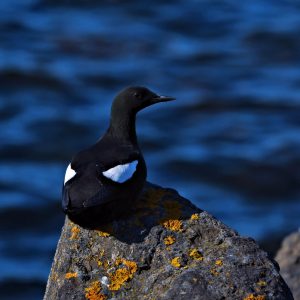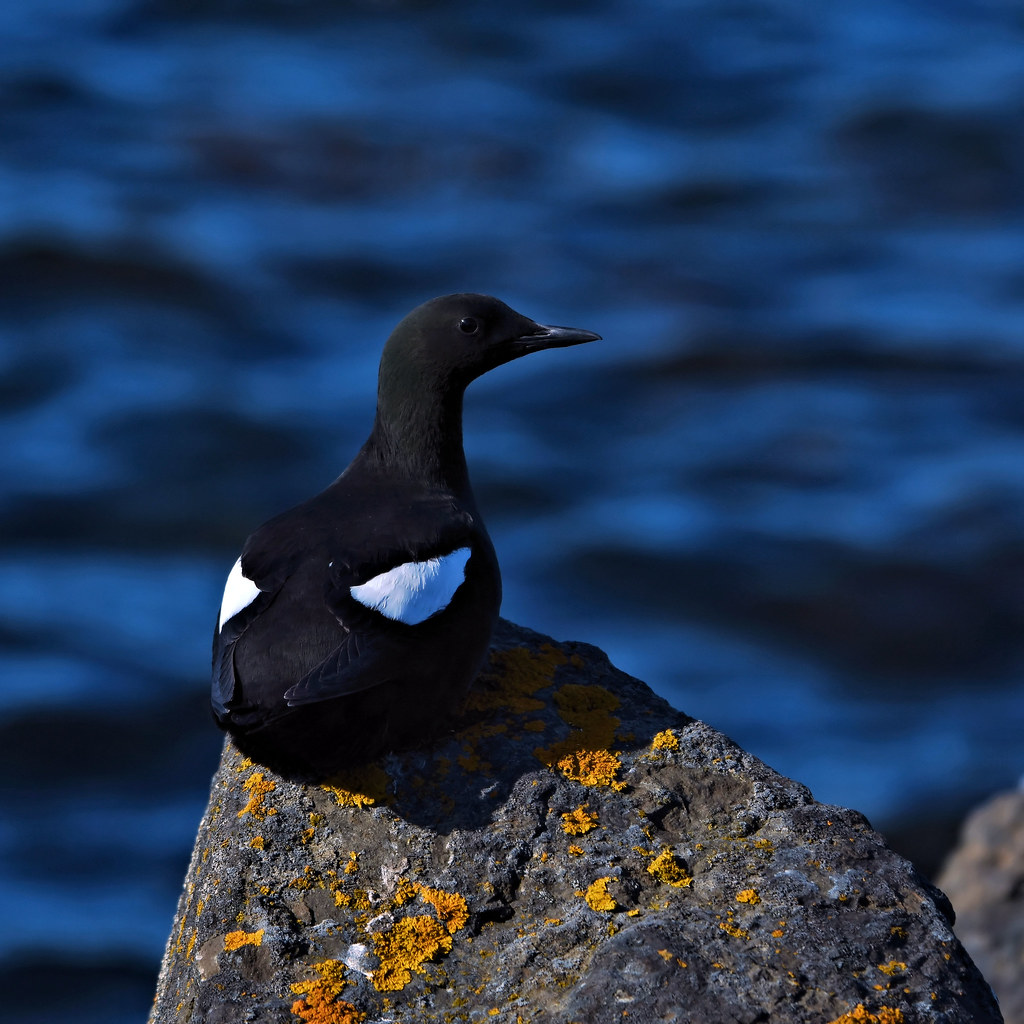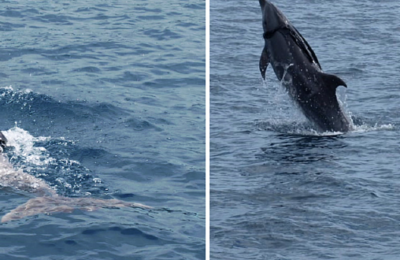
The Black Guillemot is a plump little seabird that lives along the Atlantic coast from the Arctic to the Gulf of Maine. Like other open-ocean birds including their cousins, the Puffin and Razorbill, Guillemots are sensitive to environmental changes and can be used as an environmental indicator in marine habitats. It’s important, then, that we understand these birds’ habits and life histories.
Guillemots nest on rocky cliffs and islands during the spring and early summer but it’s unclear where they go during the winter non-breeding period, which takes up most of the year.
Over 2018-2019, researchers from Dalhousie University, the Canadian Wildlife Service, University of New Brunswick, and Acadia University set out to track Black Guillemots as they moved from two breeding islands off the coast of Nova Scotia and New Brunswick to their winter homes, somewhere out to sea. They used a combination of geolocators, positioned in small tags on the birds legs, and stable isotope analysis, or estimates of carbon and nitrogen isotopes in the birds’ feathers, to determine where the Guillemots traveled during the cold months.
Stable isotope analysis is often used where tags may be impractical to use or expected to negatively affect the birds, and give the researchers an understanding of what kinds of food the birds are eating (with carbon isotopes higher in inshore fishes and nitrogen isotopes higher up the food chain). Altogether, the researchers tracked 20 birds from Country Island Nova Scotia and 12 birds from Kent Island New Brunswick, retrieving some of their tagged birds and relying on isotope analysis for the rest.

They found that birds from both breeding islands occupied a large but different at-sea area during the non-breeding season. Some Country Island birds remained near their breeding colony on the Scotian Shelf, on the Atlantic side of Nova Scotia, while others moved to the Gulf of St. Lawrence, Bay of Fundy, or Gulf of Maine. Kent Island birds, though, remained in the Bay of Fundy or moved to the Gulf of Maine, indicating that Guillemot populations have different migration strategies.

They also found that some birds dispersed up to ~390km offshore, past the continental shelf break and hundreds of kilometres further than at-sea observations suggested Guillemots traveled. Some Country Island birds traveled to distant locations where they overlapped with birds from Kent Island. Guillemots, like many other seabirds, stick to their own populations during the breeding season to avoid competition. The researchers suggest that in the winter, the birds might share a common prey resource or are following migration routes learned from parents that previously moved between colonies. Atlantic herring, code, sandlace, and other common prey species for Guillemots, are concentrated in the Gulf of Maine and Bay of Fundy, where high tides and vertical mixing ensure greater productivity even in the winter months. This may explain the dramatic travels of some Country Island birds.
Interestingly, birds that remained within just a few hundred kilometres of their breeding colony over winter still showed signs of changing diets throughout the season. Changes from a carbon isotope-dominated diet near shore to a nitrogen-dominated diet off shore might reasonably be expected from birds traveling the long distance from Country Island to the Gulf of Maine, but this change was seen in some birds that stuck around near shore. These birds, the researchers say, must be changing their feeding habits over the year for some reason, from prey species lower on the food chain to those higher up.
The researchers stress that their findings reinforce the importance of areas like the Gulf of Maine and the Bay of Fundy for the many ways these waters support a wide diversity of marine life. These areas are warming faster than many others, and the researchers suggest that ongoing tracking of the two populations would allow us to better predict how seabirds will respond to climate change. In the meantime, we now know more about the mysterious wintertime habits of this northern indicator species and can use that to inform conservation measures for many pelagic seabirds.
BAAK, J.E., LEONARD, M.L., GJERDRUM, C., DODDS, M.D. & RONCONI, R.A. 2021. Non-breeding movements and foraging ecology of the Black Guillemot Cepphus grylle in Atlantic Canada. Marine Ornithology 49: 57–70.
Hi! I’m Rebecca Parker. I’m an ecologist and plant lover working in non-profit conservation in Nova Scotia Canada. I trained at Dalhousie and Ryerson University, where I completed a Masters in Environmental Science and Management. I like botany, wetlands, and wetland botany! On the sciencey side, I like to write about current topics in population and community ecology, but I’m also really interested in environmental outreach, how exposure to science and demographics affect environmental values and behaviours, and best practices for building community capacity in environmental stewardship. Check out my instagram for photos of the awesome nature I see through my work.




I have seen a black guillemot near Hirtle Cove in Mahone Bay harbour on a number of occasions recently – most recently Jan 1,2024